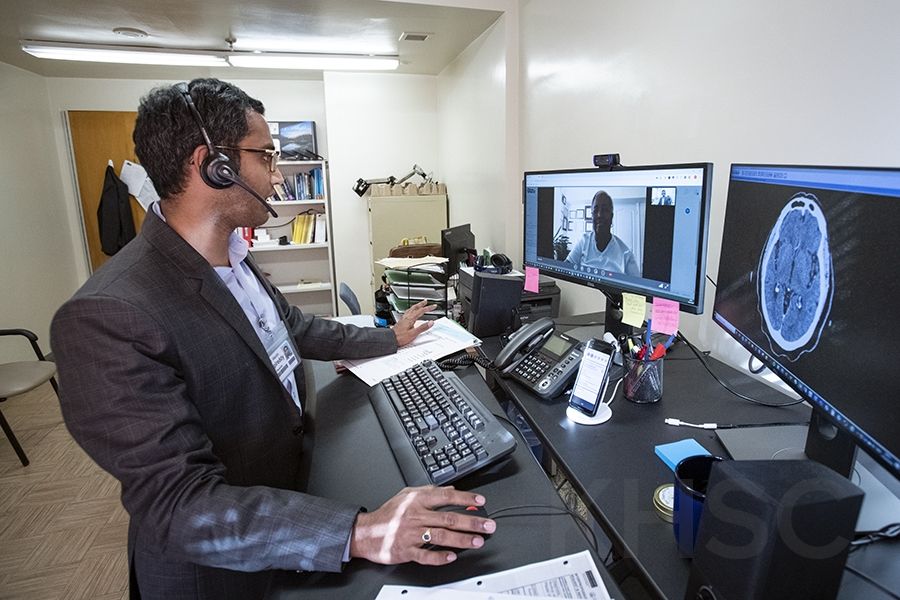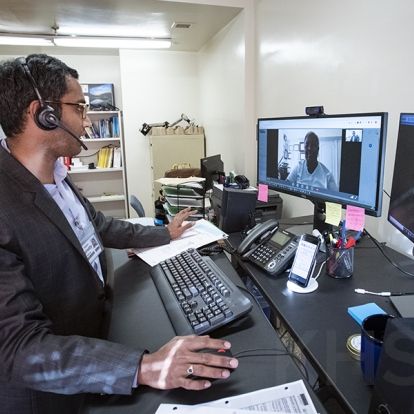Effective immediately masking is required for everyone when present on all inpatient units, in the Emergency Department (ED), the Urgent Care Centre (UCC), and the Children’s Outpatient Centre (COPC).

“I felt as if I was in your office talking to you face to face,” said a 90-year-old participant, one of 75 people who took part in a 6-month pilot project to determine if electronic visits or eVisits could be used to conveniently connect patients and families to their Kingston Health Sciences Centre (KHSC) specialists for follow-up care after a stroke.
An important outcome of the project was a 23 per cent reduction in the average number of days people wait for a follow-up visit. Waiting less means specialists are able to identify risks and interventions sooner, and help people follow their treatment plans. As well, the project produced high patient satisfaction. Nearly all participants surveyed said that their eVisits saved them time and money, and 94 per cent felt their eVisits were the same or better than in-person visits.
For the mostly senior patients who participated in the project, having the option of a follow-up eVisit and not having to travel to a medical appointment was welcomed, especially for people with limited mobility, living in rural communities, and for those faced with driving in bad weather last fall and into winter when the pilot project took place.
One 88-year-old participant and survey respondent said, “It was nice not to have had to drive to the hospital, pay for parking, and make the physical effort of getting to the appointment destination.”
“Whenever we can address the barriers people face, we are putting patients and their families at the centre of their care and improving their access to health care,” says Dr. Ramana Appireddy, stroke neurologist and medical director at KHSC’s Stroke Prevention Clinic. ”In addition to providing patient-centred care and improving access, the use of virtual care has the potential to reduce health care costs per person.”
Compared to traditional telemedicine – which requires patients and families to go to satellite telemedicine sites, and are expensive because they need specialized infrastructure and personnel to work at the sites – eVisits simplify telemedicine when possible by allowing people to stay at home and use their own computers, smartphones and tablets.
Like all telemedicine services used across Ontario, eVisits are done through a secure web platform provided by the Ontario Telemedicine Network (OTN), a not-for-profit organization funded by the Government of Ontario. The OTN eVisit platform offers unique features, including the ability for up to six more participants (family, caregivers, or other health care team members) to join the videoconference from their separate locations.
Whether at the same location or not, 60 per cent of the pilot project’s eVisits involved family members, enabling them to be of greater support to their loved ones, particularly seniors.
The technology that supports eVisits also allowed KHSC specialists to share their screens with participants so they could see and better understand test results such as those from CT and MRI scans.
“I found the ability to accurately reconcile the medications people are taking with the medication list I obtained from their pharmacy to be an extremely valuable function of eVisits,” says Dr. Appireddy. “People don’t always remember to bring all their medications to in-person appointments. eVisits make it easy for people to simply show me what they have at home.”
For patients meeting specific clinical criteria and who have access to the technical requirements, the pilot project has proven that technology can enable specialists to successfully deliver follow-up care, or care requiring less in-person interaction, to patients and families in our region using eVisits.
Since the pilot project finished in January of this year, eVisits are routinely used by all three stroke neurologists in the KHSC Stroke Prevention Clinic and have been expanded to other KHSC specialty areas in the medicine program, such as epilepsy, movement disorders, obstetrics and endocrinology.
$7,000 in funding was provided by Queen’s University’s Department of Medicine to provide the additional administrative support needed for the pilot project.
Gallery


Dr. Ramana Appireddy, stroke neurologist and medical director at KHSC’s Stroke Prevention Clinic, with a patient during an eVisit.



